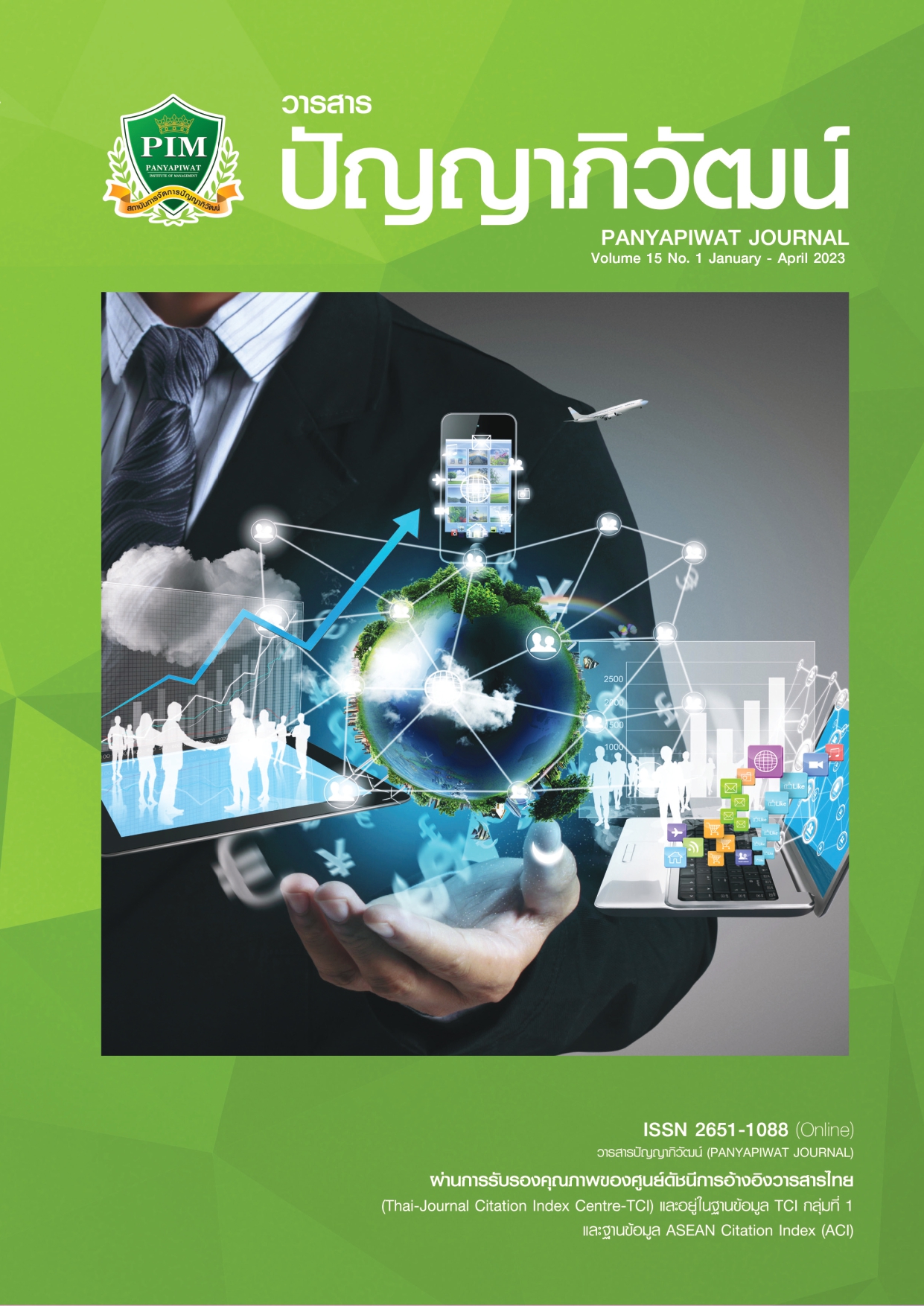การศึกษาปัจจัยที่มีผลต่อการเปลี่ยนผ่านสู่ความเป็นดิจิทัล สำหรับวิสาหกิจขนาดกลางและขนาดย่อมในประเทศไทย
Main Article Content
บทคัดย่อ
ในปัจจุบันการพัฒนาทางด้านเทคโนโลยีดิจิทัลมีความก้าวหน้าไปถึงขั้นที่สามารถนำไปประยุกต์ใช้ในการดำเนินชีวิตของบุคคลทั่วไปอย่างกลมกลืน เนื่องจากเทคโนโลยีนี้ได้ถูกออกแบบให้คนที่ไม่มีพื้นฐานทางด้านเทคโนโลยีดิจิทัลก็สามารถที่จะใช้งานได้อย่างง่ายดายเพื่อให้ชีวิตมีความสะดวกสบายขึ้น ในการดำเนินการทางธุรกิจที่มุ่งในการแข่งขันกันก็เช่นเดียวกัน จะเห็นได้ว่ามีธุรกิจชนิดเดิมแต่ได้ถูกนำเสนอให้ลูกค้าผ่านวิธีการใหม่ ๆ ผ่านเทคโนโลยีดิจิทัลจนกระทั่งทำให้ธุรกิจต่าง ๆ ที่ยังดำเนินธุรกิจแบบเดิมประสบปัญหาในการแข่งขันอาจจะต้องปิดตัวลงถ้าไม่มีการเปลี่ยนแปลง ในส่วนของธุรกิจขนาดใหญ่มีการทุ่มงบประมาณและกำลังคนเพื่อที่จะก้าวผ่านช่วงที่เปลี่ยนแปลงทางเทคโนโลยีดิจิทัลที่สำคัญในครั้งนี้ ส่วนกลุ่มวิสาหกิจขนาดกลางและขนาดย่อมเป็นกลุ่มที่มีความสำคัญต่อการพัฒนาระบบเศรษฐกิจของประเทศนั้นก็จะต้องมีการปรับตัวอย่างสูงเช่นเดียวกัน แต่เนื่องจากกลุ่มวิสาหกิจขนาดกลางและขนาดย่อมจะมีความขาดแคลนหลายด้านเพราะอยู่ในช่วงการพัฒนาธุรกิจ ดังนั้นการเริ่มพัฒนาธุรกิจโดยมีเทคโนโลยีดิจิทัลเป็นพื้นฐานในการสร้างธุรกิจอย่างยั่งยืน ในการศึกษาครั้งนี้จึงมุ่งเน้นไปที่การศึกษาในกลุ่มวิสาหกิจขนาดกลางและขนาดย่อมของประเทศไทย โดยมีการเสนอแบบจำลองปัจจัยของการเปลี่ยนผ่านขององค์กรสู่ความเป็นดิจิทัลของกลุ่มวิสาหกิจขนาดกลางและขนาดย่อมของประเทศไทย โดยทำการเก็บข้อมูลจากวิสาหกิจขนาดกลางและขนาดย่อมในประเทศไทย ด้วยแบบสอบถาม จำนวน 400 ราย ด้วยวิธีการสุ่มตัวอย่างแบบหลายขั้นตอน ผลการวิจัยพบว่า 1) ผู้ประกอบการในกลุ่มวิสาหกิจขนาดกลางและขนาดย่อมมีความเห็นว่า ปัจจัยด้านการจัดการองค์การ เทคโนโลยีสารสนเทศ นวัตกรรม ดิจิทัลทรานส์ฟอร์เมชันและผลการดำเนินงานธุรกิจ มีระดับความสัมพันธ์กันในระดับมาก 2) ปัจจัยด้านการจัดการองค์การ เทคโนโลยีสารสนเทศ นวัตกรรม ส่งผลต่อดิจิทัลทรานส์ฟอร์เมชัน และผลการดำเนินงานธุรกิจทั้งทางตรงและทางอ้อม และ 3) แบบจำลองดิจิทัลทรานส์ฟอร์เมชันของวิสาหกิจขนาดกลางและขนาดย่อมในประเทศไทยที่เสนอ สามารถนำมาใช้เป็นแนวคิดในการพัฒนาดิจิทัลทรานส์ฟอร์เมชันของวิสาหกิจขนาดกลางและขนาดย่อมในประเทศไทย
Article Details

อนุญาตภายใต้เงื่อนไข Creative Commons Attribution-NonCommercial-NoDerivatives 4.0 International License.
“ข้าพเจ้าและผู้เขียนร่วม (ถ้ามี) ขอรับรองว่า บทความที่เสนอมานี้ยังไม่เคยได้รับการตีพิมพ์และไม่ได้อยู่ระหว่างกระบวนการพิจารณาลงตีพิมพ์ในวารสารหรือแหล่งเผยแพร่อื่นใด ข้าพเจ้าและผู้เขียนร่วมยอมรับหลักเกณฑ์การพิจารณาต้นฉบับ ทั้งยินยอมให้กองบรรณาธิการมีสิทธิ์พิจารณาและตรวจแก้ต้นฉบับได้ตามที่เห็นสมควร พร้อมนี้ขอมอบลิขสิทธิ์บทความที่ได้รับการตีพิมพ์ให้แก่สถาบันการจัดการปัญญาภิวัฒน์หากมีการฟ้องร้องเรื่องการละเมิดลิขสิทธิ์เกี่ยวกับภาพ กราฟ ข้อความส่วนใดส่วนหนึ่งและ/หรือข้อคิดเห็นที่ปรากฏในบทความข้าพเจ้าและผู้เขียนร่วมยินยอมรับผิดชอบแต่เพียงฝ่ายเดียว”
เอกสารอ้างอิง
Alagoa, H. E. (2016). Organizational digital transformation anticipating and planning for the paradigm shift. https://doi.org/10.2139/ssrn.2588347
Angsuchote, S., Vijitwanna, S., & Phinyopanuwat, R. (2015). Stratistical analysis for social science research and behavioral: Techniques for using LISREL (4th ed.). Rongphim Charoendi Mankhong Kanphim.
Berghaus, S., & Back, A. (2016). Stages in digital business transformation: Results of an empirical maturity study. In Mediterranean Conference on Information System 2016 Proceeding (pp. 1-17). AIS Electronic Library (AISeL). https://aisel.aisnet.org/mcis2016/22/?utm_source=aisel.aisnet.org%2Fmcis2016%2F22&utm_medium=PDF&utm_campaign=PDFCoverPages
Chen, Y. Y. K., Jaw, Y. L., & Wu, B. L. (2016). Effect of digital transformation on organizational performance of SMEs: Evidence from the Taiwanese tactile industry’s web portal. Internet Research, 26(1), 186-212.
Drucker, P. F. (1985). Innovation and entrepreneurship: Practice and principles. Harvard Business Review, 76(6), 149-157.
Ferreira, J. J. M., Fernandes, C. I., & Ferreira, F. A. F. (2019). To be or not to be digital, that is the question: Firm innovation and performance. Journal of Business Research, 101(August), 583-590.
Gudergan, G., & Mugge, P. (2017). The gap between practice and theory of digital transformation. In Hawaii International Conference of System Science, Hawaii (pp. 1-15). ResearhGate. https://www.researchgate.net/publication/318864420_The_Gap_Between_the_
Practice_and_Theory_of_Digital_Transformation
Gupka, S. (2018). Organizational barriers to digital transformation [Master’s thesis]. KTH Royal Institute of Technology, School of Industrail Engineering and Management.
Henriette, E., Feki, M., & Boughzala, I. (2015). The shape of digital transformation: A systematic literature review. In 9th Mediterranean Conference on Information Systems (MCIS), Samos, Greece, 2015 (pp. 431-443). AIS Electronic Library (AISeL). https://aisel.aisnet.
org/mcis2015/
Kohnke, O. (2017). It’s not just about technology: The people side of digitization. In G. Oswald, & M. Kleinemeier (Eds.), Shaping the Digital Enterprise. Trends and Use Cases in Digital Innovation and Transformation (pp. 69-91). ResearhGate. https://www.researchgate.net/publication/308671468_Its_Not_Just_About_Technology_The_People_Side_of_Digitization
Kwon, E. H., & Park, M. J. (2017). Critical factors on frm’s digital transformation capacity: Empirical evidence from Korea. International Journal of Applied Engineering Research, 12(22), 12585-12596.
Lazarevic, S., & Lukic, J. (2018). Team learning process and activities in organization: A case study. Economic Themes, 56(3), 301-319.
Li, H., Wu, Y., Cao, D., & Wang, Y. (2021). Organizational mindfulness towards digital transformation as a prerequisite of information processing capability to achieve market agility. Journal of Business Research, 122, 700-712.
Li, L., Su, F., Zhang, W., & Ye, M. J. (2017). Digital transformation by SME entrepreneurs: A capability perspective. Information System Journal, 28(6), 1129-1157.
Libert, B., Beck, M., & Wind, Y. (2016). 7 questions to ask before your next digital transformation. Harvard Business Review, 60(12), 11-13.
Mirkovic, V., Lukic, J., Lazarevic, S., & Vojinovic, Z. (2019). Key characteristics of organizational structure that supports digital transformation. In 24th International Scientifc Symposium: Strategic Management and Decision Support Systems in Strategic Management (pp. 255-261). Faculty of Economics in Subotica, University of Novisad. https://doi.org/10.46541/978-86-7233-380-0_46
Morakanyane, R., Grace, A., & O’Reilly, P. (2017). Conceptualizing digital transformation in business organizations: A systematic review of literature. In30thBled Conference: Digital Transformation from Connecting Things to Transforming Our Lives (pp. 427-443). AIS Electronic Library (AISeL). https://aisel.aisnet.org/bled2017/21
Nadeem, A., Abedin, B., Cerpa, N., & Chew, E. (2018). Editorial: Digital transformation & digital business strategy in electronic commerce-The role of organizational capabilities. Journal of Theoretical and Applied Electronic Commerce Research, 13(2), 1-8.
Nwankpa, J. K., & Rounami, Y. (2016). IT capability and digital transformation: A from performance perspective. In Thirty Seventh International Conference on Information System, Dublin (pp. 1-16). AIS Electronic Library (AISeL). https://aisel.aisnet.org/icis2016/ISStrategy/Presentations/4/
Office of Small and Medium Enterprises Promotion. (2022). Situation report MSME 2022. Office of Small and Medium Enterprises Promotion.
Piccinini, E., Hanelt, A., Gregory, R. W., & Kolbe, L. M. (2015). Transforming industrial business: The impact of digital transformation on automotive organization. In 36th International Conference on Information System, Fort Worth 2015 (pp. 1-20). ResearhGate. https://www.researchgate.net/publication/281855658_Transforming_Industrial_Business_The_Impact_of_Digital_Transformation_on_Automotive_Organizations
Ross, P., & Blumenstein, M. (2013). Cloud computing: The nexus of strategy and technology. Journal of Business Strategy, 34(4), 39-47.
Schilling, M. A. (2008). Strategic management of technological innovation (2nd ed.). McGraw-Hill Education.
Stief, S. E., Eidhoff, A. T., & Voeth, M. (2016). Transform to succeed: An empirical analysis of digital transformation in frms. World Academy of Science, Engineering and Technology International Journal of Economics and Management Engineering, 10(6), 1833-1842.
Trantopoulos, K., Krogh, G. V., Wallin, M. W., & Woerter, M. (2017). External knowledge and information technology: Implications for process innovation performance. MIS Quarterly, 41(1), 287-300.
Westerman, G., & Bonnet, D. (2015). Revamping your business through digital transformation. MIT Sloan Management Review, 56(3), 10-13.
Westerman, G., Bonnet, D., & McAfee, A. (2014). Leading digital: Turning technology into business transformation. Hardvard Business Publishing.
Wongchaikul, P., Klongklaw, C., & Jaiwach, W. (2020). Digital: Open 3 reasons why SME don’t transform. Positionning.
Yamane, T. (1970). Statistic: An introductory analysis (2nd ed.). Harper & Row.
Zhang, Y., Khan, U., Lee, S., & Salik, M. (2019). The influence of management innovation and technological innovation on organization performance. A Mediating Role of Sustainability, 11, 1-21.


